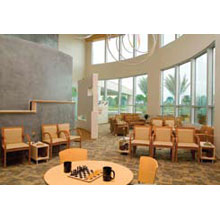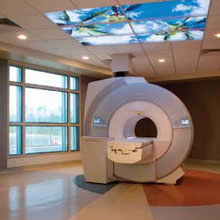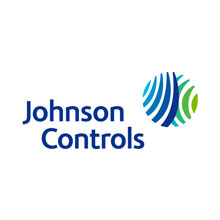 |
| Johnson Controls provided guidance and support for the project team, using Green Compass, a software application tool and services |
Parrish Medical Center (PMC), a state of Florida tax district entity, operates as a not-for-profit hospital serving North Brevard County, Florida, since 1958. PMC, based in Titusville, has continuously expanded its services and facilities to meet the needs of a growing community.
Building for sustainability is a natural extension of Parrish Medical Center’s commitment to the creation of patient-centered healing experiences. PMC leadership and staff believe that the physical environment can play a significant role in patient care. This belief is evidenced by the center’s collaboration with Johnson Controls to use green design and a lifecycle approach in the construction of its new outpatient facility, Parrish Healthcare Center at Port St. John. The facility earned the first Leadership in Energy and Environmental Design (LEED®) silver certification for a healthcare outpatient building in the state of Florida. The certification recognises high-performance buildings that benefit the occupants as well as the environment.
The new outpatient healthcare campus is meeting the needs of the growing population in Port St. John, a community located just 20 miles south of the main hospital. The 33-acre site includes nature trails and a wildlife preserve land allocation, which is a LEED credit. Approximately 60 healthcare professionals and support staff work at the 72,500-squarefoot center, which houses diagnostic imaging, physical therapy and rehabilitation, a sleep-disorder lab and physician’s offices.
“We’re proud to have built a facility that is what the community asked for. Too often a facility is created with little or no community input, which was not the case here,” says Chris Fox, director of the Parrish Healthcare Center at Port St. John.
“The fact that the new Port St. John health care center is also ‘green’ is a tremendous benefit for the community and a reason for them to be proud of what they created with Parrish, “adds Christopher Male, FACHE, medical center developer, responsible for select facility development projects at PMC.
Collaborative approach to building for sustainability
PMC’s vision of creating the best healing experience for patients on a continuous basis helped shape the design of the new outpatient center. Hospital leadership understands that building for sustainability requires a long-term, lifecycle approach and smart decisions throughout the construction process. By taking a collaborative approach with the design and construction team and Johnson Controls, PMC was successful in bringing together different professional perspectives and then deciding what is best, based on healthy, patient-centered outcomes.
To assist with this process Johnson Controls conducted an Innovation Services workshop with key stakeholders and the design team to help explore approaches for cost-effectively integrating systems, infrastructure and technology. The workshop provided a forum for defining and communicating PMC’s vision and objectives, and aligning the building design and technology with those goals. Innovation Services’ collaborative process allowed internal and external stakeholders to be involved early in the planning and helped meet one of the primary goals uncovered in the workshop – that all stakeholders in the new project succeed together to win. In addition, Innovation Services improved the upfront planning process, which helped meet the goal of remaining on budget and meeting individual expectations.
Serving as the LEED accredited professional for the project, Johnson Controls provided guidance and support for the project team, using Green Compass, a software application tool and services which allowed the priorities defined in the workshop to be aligned with the LEED rating system. By aligning with the LEED objectives defined in this process, PMC was able to impact mission-critical goals.
As the green building advocate with Male, Johnson Controls assessed the design with the project team as well as evaluated credits for cost, payback and mission alignment to establish the certification scope. Johnson Controls further reviewed all design documents, offering design assistance and bringing lifecycle considerations to the table that would provide savings in both first costs and operational costs while assuring project goals were met. A model of the building’s energy consumption created by the design team was reviewed by Johnson Controls, which allowed a performance guarantee to be tied to the project. Another way that the team managed project costs, was to leverage Novation, a contracting services company that helps manage and reduce supply costs for VHA, University Healthsystem Consortium and Provista.
Johnson Controls also serves as the facility lifecycle performance partner, helping ensure that long-term energy consumption for HVAC equipment and lighting will remain within a specific range required for LEED certification. A Johnson Controls Metasys® building management system allows for the measurement and verification of energy use, which contributes to LEED project goals.
 |
| Johnson Controls is responsible for maintaining the building controls, security system and HVAC equipment |
Specifically, Johnson Controls served as the design assist and construction manager for the critical building systems including mechanical, plumbing, electrical, building controls, information technology and security systems. This included management of subcontractors and installation of the Metasys system and a Johnson Controls P2000 security management system. Additionally, Johnson Controls recommended and installed a YORK® air-cooled chiller instead of the packaged rooftop unit specified in earlier project designs. The air-cooled chiller resulted in lower installation and operating costs. Johnson Controls is responsible for maintaining the building controls, security system and HVAC equipment under a service agreement.
LEED supports hospital’s design approach
PMC leadership chose to pursue the LEED approach to new construction after learning about it from leaders in the field of sustainable design, including Johnson Controls. “LEED supports our evidence-based design approach by incorporating elements we’ve found to be important to healing while providing additional benefits to our operations.” says Male. “Interesting similarities exist between evidence-based design and LEED. By combining the two we can maximise benefits to patients, the environment, clinical performance and administrative efficiency,” adds Fox.
Evidence-based design seeks to identify the effect of the environment on patients and staff, and guide decisions. Research indicates that environments play an integral role in healing the body, mind and spirit. Pursuing LEED helped to achieve a “healthy building,” one of seven elements of a healing environment that PMC wanted to provide the community. Other elements include nature, color, healthy lighting, physical security, wayfinding and cultural responsiveness.
As the LEED certification consultant, Johnson Controls collaborated with PMC staff and the design team from concept to completion to achieve a design based on patient-centered outcomes that meet LEED requirements. To receive certification, criteria must be met in six broad categories including sustainable site development, water conservation, energy and atmosphere, materials and resources, indoor environmental quality, and innovation and design. Johnson Controls assisted PMC in the LEED submittal process.
“The LEED certification process served as a guide for creating something that is much more than just a building,” says Male. “We feel we have created a destination that will positively affect everyone who comes into contact with it.”
Design incorporates seven elements of a healing environment:
NatureThe greenfield site development and design emphasises the natural beauty. The existing ecology was respected by incorporating the vegetation into the design. The natural, healing elements transition into the interior by placing plants and a fountain in the atrium.
Color and healthy lighting
“We feel we have created a destination that will positively affect everyone who comes into contact with it” |
These two elements are complementary and are considered together. The choice of interior finishes respect the color and texture of the site’s vegetation. Bright finishes and sophisicated lighting contribute to the healing environment.
Healthy building
The interior building materials use recycled content, emit low VOCs and are easily maintained, which enhance the building’s sustainability. Incorporating quiet patient areas and designing for patient flow creates a therapeutic environment.
Physical security
A state-of-the-art Johnson Controls security system protects patients, visitors and employees. The center is built to withstand 130 mph winds and is above the 100-year flood plain.
Wayfinding
Good wayfinding such as clear and visible graphics and signage, which denote different areas of the building, create a sense of place.
Cultural responsiveness
The center contains colors, fabric textures and artwork that are specific to the local habitat.
Parrish Healthcare Center at Port St. John incorporated the following features in order to qualify for LEED certification:
Sustainable site development
- Building footprint is equal to or less than the surrounding space
- Storm water is managed and treated
- Reflective roofing material reduces heat gain
- Preferred parking available to high efficiency, alternative fuel vehicles and carpoolers
- Bicycle racks and showers available
- Light retained on-site at PMC and at minimal levels to reduce light pollution to surrounding areas
Water conservation
- Use of native vegetation requires 50% less watering
- Holding ponds trap rain water for use in irrigation
- Low-flow plumbing fixtures reduce water usage by 20%
- Dual flush toilets, waterless urinals reduce water usage by 30%
 |
| Johnson Controls Metasys building management system allows for the measurement and verification of energy use |
Energy and atmosphere
- High-efficiency lighting incorporates occupancy and daylighting sensors
- High-efficiency YORK HVAC equipment uses the least harmful refrigerants
- Integrated Johnson Controls Metasys building management system used for measurement and verification
Materials and resources
- Implemented policies and procedures for recycling
- 50% of construction waste was diverted from landfills
- 10% of construction materials contain recycled content
- 60% of manufactured materials were obtained within 500 miles of the site
Indoor environmental quality
- No smoking policy established
- Indoor air quality management plan implemented for subcontractors
- Low VOC adhesives, sealants, paints, carpeting and composite woods were used
- Metasys system monitors and controls HVAC equipment for maximised efficiency and thermal comfort within ASHRAE standards
- Metasys system maintains indoor air quality by monitoring CO2 levels and introducing outside air when necessary
- Building flushed out prior to occupancy
Innovation and design
- Implemented Johnson Controls Sustainable Energy & Education Communications program for Parrish Heathcare Center staff
- Educational kiosk informs visitors and patients of sustainable features
- Implemented high-performance green housekeeping program
- Johnson Controls provided multiple, LEED-accredited professionals from concept through completion
- Land dedicated to nature preserve provides healthy healing environment and provides habitat for endangered Scrub-Jay
Find out the state of adoption, trends and opportunities with Artificial Intelligence (AI) in physical security.
























